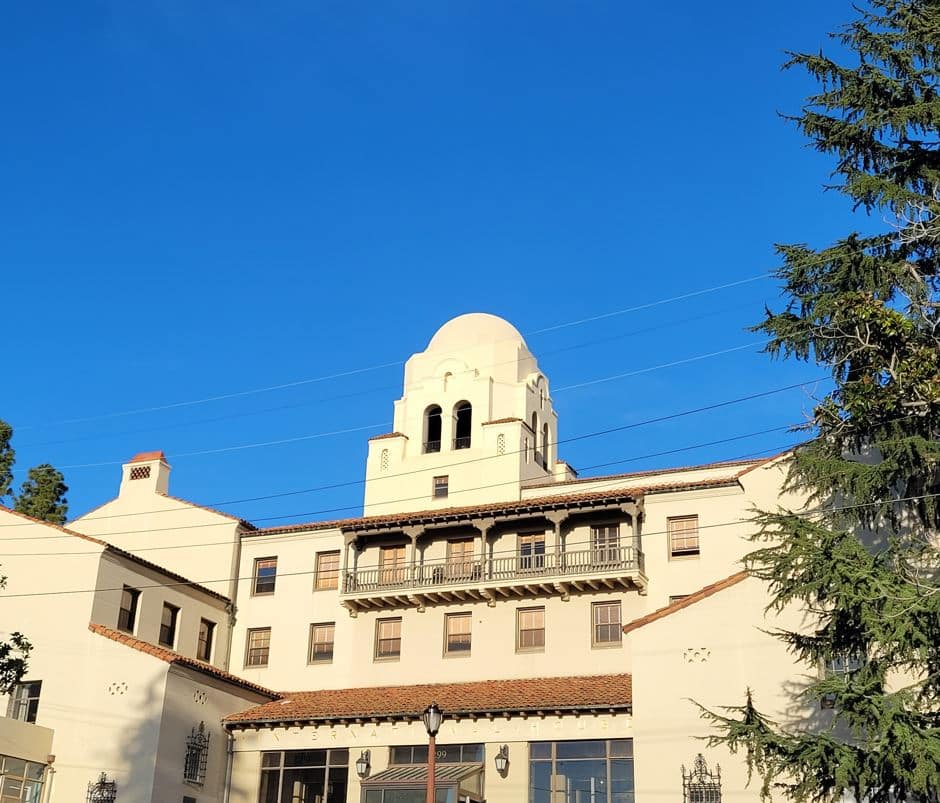
Have you heard of “International House,” aka “I-House”? I had never heard of it until 2022 when I found out that such a place existed at UC Berkeley. And after learning about its history and significance, I wish UCLA had an International House as well! Alas, it is only exclusively at Berkeley, NYC, Chicago, Paris, and Tokyo.

Here’s a post dedicated to International House and its incredible story!
The International House Movement

Available online HERE.
According to official sources, International House, Berkeley was founded by Harry E. Edmonds with the financial support of John D. Rockefeller Jr. It was the second International House to be built after the first one was founded in NYC in 1924 (also funded by Rockefeller Jr.). Harry Edmonds felt the need to create these “multi-cultural residence and program” centers after discovering the lack of community and support foreign students faced in the U.S.
Here is Edmonds’s chance encounter with a Chinese student that sparked the I-House movement:
“One frosty morning I was going up the steps of the Columbia library when I met a Chinese student coming down. I said, ‘Good morning.’ As I passed on, I noticed he stopped. I went back.
“He said, ‘Thank you for speaking to me. I’ve been in New York three weeks and you are the first person who has spoken to me.’
“With my wife’s insistence, I agreed I had to do something.”
Harry E. Edmonds from The New York Times1
When the second I-House opened its doors in Berkeley on August 18, 1930, it was the “largest student housing complex in the Bay Area and the first coeducational residence west of New York” (International House at UC Berkeley). Even UC Berkeley didn’t have coed housing yet!
As part of the progressive I-House movement amidst the political and social climate of the time, it was met with much resistance in Berkeley. According to the official I-House history book, there was much resistance to men and women as well as foreigners, people of color, and whites living under one roof. And so, it’s all the more incredible that Harry Edmonds chose Piedmont Avenue, “home of fraternities and sororities, which then excluded foreigners and people of color,” as the site for the second International House (International House Berkeley: An Extraordinary History, 2).

Available online HERE.
Decades of History

Through the decades, I-House truly lived up to its mission of intercultural respect, understanding and friendship. Some major examples include:
- In the 1930s, Allen Blaisdell, the first Executive Director of I-House Berkeley, protested against barbers on campus who refused to cut Black students’ hair and changed the practice.
- In the 1940s, when Japanese American students faced difficulties, International House “set up a bureau to help these young people reach their homes as soon as government regulations permitted” and “helped them with their finances by locating employment opportunities” (International House Berkeley: An Extraordinary History, 3).
HERE is a really great presentation by the Executive Director Emeritus, Joe Lurie, on the role I-House played in desegregating Berkeley.
Reading the official International House history book and listening to Mr. Lurie and different I-House alumni, it sounded to me that I-House had been a place where students from around the world got to live with each other, learn from one another, and form lasting bonds across borders. I hope that, as the institution approaches its 100th year (in 2030), it continues to do so.

Architecture

The man behind the iconic I-House Berkeley building is none other than George W. Kelham, the prolific American architect who also designed the Asian Art Museum (formerly the old San Francisco Public Library); the Roble Hall at Stanford University; Powell Library, Haines Hall, Kerckhoff Hall and more at UCLA; Bowles Hall, Valley Life Sciences Building, Moses Hall (now the “Philosophy Hall”), McLaughlin Hall, Davis Hall, Edwards Stadium, Haas Pavilion, and more at UC Berkeley; and countless more!


And like the many other buildings Kelham designed, I-House at Berkeley is beautiful, with intricate designs and shapes evoking Spanish and Mediterranean architecture with hints of Moorish influences.


And how fitting, too, as California’s long and complex history includes the Spanish colonial period.









Notable I-House Alumni
As one would expect from a residential building created for scholars from around the world gathered in Berkeley to attend its top university, there are countless notable alumni of International House. A list can be found on the official I-House Berkeley website HERE. Among numerous pioneers, Nobel prize recipients, professors and founders, here are just a few of the brilliant men and women who lived at I-House:

Chien Shiung Wu Yuan – Chinese-American physicist, professor at Columbia University, and pioneer who made great contributions in experimental physics and atomic science and to the Manhattan Project. There’s a photo of J. Robert Oppenheimer and Dr. Chien-Shiung Wu having dinner at International House Berkeley shared by the Los Alamos National Laboratory HERE.

Julian Schwinger – one of the greatest physicists of the 20th century, professor at Harvard University, and Nobel Prize winning American theoretical physicist who developed a relativistically invariant perturbation theory. He did postdoctoral research at UC Berkeley under Oppenheimer and assisted in research at the University of Chicago Metallurgical Laboratory for the Manhattan Project.

Emmett J. Rice – an American economist, bank executive, and member of the Federal Reserve Board of Governors who served in the U.S. Air Force during WW II as a member of the Tuskegee Airmen. A Fulbright scholar, he integrated the Berkeley Fire Department as its first African American fireman. He was also the father of Susan Rice, former U.S. ambassador to the United Nations and former National Security Advisor.

from Federal Reserve History.
Eric & Wendy Schmidt: American businessman, former software engineer, CEO of Google (2001-2011), executive chairman (2011-2015) & American businesswoman and philanthropist. The two met at I-House.


Here’s another photo of Wendy & Eric Schmidt from the I-House blog, I-House: Where UC Berkeley Meets the World.
Eric and Wendy Schmidt seem to have revisited I-House a couple of times. Notably, Wendy Schmidt visited when she was honored as I-House’s Alumni of the Year at the 2014 I-House Gala along with another notable alumni, Dr. Ashok Gadgil, and Eric Schmidt came by very recently for the I-House Executive Director’s Lodestar Speaker Series: “The Promise and Perils of AI” event this year.
And I believe, the Dining Commons has been named after the I-House couple.
Countless More Notable Alumni

This blog post would not end if I were to explore all notable I-House alumni, which includes Abdelkader Abbadi (former UN Director of Political Affairs and journalist), Choong Kun Cho (former president of Korean Air), Hans Rausing (former chairman of TetraPak)and his daughter Lisbet Rausing (senior research fellow at Imperial College, London and author), and Haakon Magnus (Crown Prince of Norway), along with Nobel Prize laureates, scientists, scholars, philanthropists, and more.
Plus, I know personally that the list shared on the official website is yet far from being comprehensive, as notable individuals such as W. Harold McClough (founder of Perth construction and Clough Limited), Walter John Jr. (distinguished aerosol physicist, research scientist, and founder), Michael J. Belton (astronomer), Gerhart Friedlander (nuclear chemist who worked on the Manhattan Project), Stewart L. Blusson (geologist and philanthropist), and so many other incredible men and women have also stayed at I-House. This fact alone is a testament to what hub of brilliant minds International House was and is!
I-House Today

Today, I-House remains sitting atop the hill overlooking Berkeley, across from the Law School. Though it retains its old silhouette, iconic dome and other features, I-House has undergone several renovations, including an addition of the ADA-complaint ramp and a complete transformation of its café (from the “I-House Café” to “Edmonds’ Café.”) Sadly, the Heller Patio has now lost the lush trees and greenery that previous residents so enjoyed and referred to as a “garden” within the busy city.

But it still houses over 600 students and scholars (both international and domestic) each year. I truly believe that the magic of the place stems from the many talented residents that bring their unique experiences and stories from around the world. I hope that International House at UC Berkeley, a remarkably unique building steeped in rich history, never loses the passion, faith, and integrity it started out with 94 years ago.

P.S. Here are some useful links related to I-House at UC Berkeley:
- The official International House at UC Berkeley website
- A blog by Harry Edmonds’ great-granddaughter, Alice Lewthwaite
- A blog post on the first I-House (in NYC) written by a recent resident at I-House Berkeley
- A fascinating, engaging book titled Perception and Deception: A Mind Opening Journey Across Cultures written by Executive Director Emeritus Joe Lurie. If you are interested in learning about cross cultural understandings and misunderstandings or just want to broaden your knowledge, I highly recommend this book!
- A book titled The Golden Age of International House Berkeley: An Oral History of the Post World War II Era, written by Jeanine Castello-Lin and Tonya Staros of Berkeley Historical Society. It’s a wonderful compilation of invaluable oral history shared by residents who lived at I-House during the late 1940s and early 1950s.
P.P.S. 2024 marks the 100th anniversary for the International House in NYC! Here is everything the first ever I-House is doing this year to celebrate: https://www.ihouse-nyc.org/centennial/
- Goodman, G. (1979, July 8). “Harry Edmonds, Who Established International House, Is Dead at 96.” The New York Times, p. 35. Retrieved from https://www.nytimes.com/1979/07/08/archives/harry-edmonds-who-established-international-house-is-dead-at-96-a.html.

Nice post Timetraveler!!!
Thank you Rainmaker! 😄👍